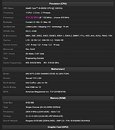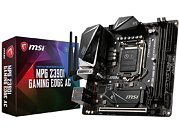Tuesday, January 15th 2019

MSI Breaks DDR4 World Record at 5608 MHz Using Z390I Gaming Edge AC
Years after year, MSI dominates the memory frequency record to show the strength on overclocking performance. Just in the beginning of 2019, MSI's in-house overclocker, Toppc, pushes the DDR4 speeds to 5.6GHz, setting another barrier using Kingston memory and the MSI Z390I GAMING EDGE AC motherboard by liquid nitrogen cooling. Undoubtedly, this is a revolutionary breakthrough for the Intel 9th generation processors for the first time. This world record not only shows MSI's dominant position on performance for Intel 9th generation processors by using MSI MPG Z390I GAMING EDGE AC and MSI's unique and patented DDR4 Boost technology, but also reveals team-up power with Kingston DDR4 memory.
More information on the record can be found here.Stay sharp with a nimble mini-ITX design but mighty power, the MPG Z390I GAMING EDGE AC is designed with premiere layout, Dr. MOS and DigitAll power. This motherboard releases all Intel 9th Gen CPU performance by MSI exclusive DDR4 Boost and Core Boost. Featuring Twin Turbo M.2 and USB Type-C to make sure the support of high-speed peripherals, MPG Z390I GAMING EDGE AC is the best motherboard choice of performance and space.
More information on the record can be found here.Stay sharp with a nimble mini-ITX design but mighty power, the MPG Z390I GAMING EDGE AC is designed with premiere layout, Dr. MOS and DigitAll power. This motherboard releases all Intel 9th Gen CPU performance by MSI exclusive DDR4 Boost and Core Boost. Featuring Twin Turbo M.2 and USB Type-C to make sure the support of high-speed peripherals, MPG Z390I GAMING EDGE AC is the best motherboard choice of performance and space.


4 Comments on MSI Breaks DDR4 World Record at 5608 MHz Using Z390I Gaming Edge AC
Then again, I don't tend to follow world records so as far as I know this could be pretty common.
In this case I think MSI specifically designed this board to do insane RAM speeds with a two slot ITX as a calculated decision. It had to be conceived specifically for record breaking in that specific area, no holds barred. I wonder what compromises came along with that though. Im sure there are good reasons why its not usually done the way it had to be done with this board to get those speeds. But that's getting beyond the limits of what I know about motherboard design. I just know that any other ITX board coudnt have done this without losing out in eiter cost, vesatility, or both. For most people, a board built to do these speeds probably isnt worth it... and thats why it isnt done... its not like it couldn't have been done before, you know? Its a matter of balancing on the engineers' parts, not necessarily engineering innovation.
5000+ is as cool as it is stupid to me. Theres a part of me that would have a blast trying for that. And then there's the pragmatist in me that asks "Why? Just... why."
In other words, this is like all most world records: (moderately) impressive on its own grounds, but useless in the real world. Unless your Z390 ITX board is running an extremely bandwidth-hungry server workload, that is.